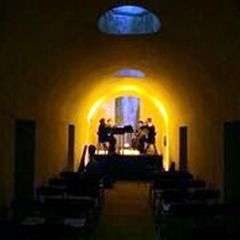|
Back
Tonal Tales from the Catacomb New York
Green-Wood Cemetery, Brooklyn
09/24/2018 -
“The Angel’s Share Presents Modern Medieval”
Rodericus: Angelorum Psalat (Arranged by Christopher Otto)
Marcos Balter: Chambers
Solage: Fumeux Fume par Fumée (Arranged by Christopher Otto)
Chaya Czernowin: String Quartet
Thomas Morley: Christes Crosse
John Zorn: The Alchemist
The JACK Quartet: Christopher Otto, Austin Wulliman (Violins), John Pickford Richards (Viola), Jay Campbell (Cello)

JACK Quartet in Green-Wood Crypt (© Kevin Condon)
“Con mortuis in lingua mortua” (“With the dead in a dead language”)
Modest Mussorgsky, pencilled note for his “Roman Catacombs” section from Pictures at an Exhibition
Grave is more than the direction for Beethoven’s Pathétique or Mussorgsky’s “Catacombs.” Graves, mausoleums and crypts are familiar to music- goers from Weber’s Freischütz to the last act of Aida to Verdi’s Falstaff and of course Mendelssohn’s Walpurgisnacht and Ives’ Halloween.
New York musical impresario Andrew Ousely has brought the dead to life in a grander way these years. First by staging concerts in an uptown church cemetery. And this year expanding the performances in Brooklyn’s 180-year-old 479-acre Green-Wood Cemetery. Not only does this mammoth hilltop site give rest to such variegated celebrities as New York icons Leonard Bernstein, Elliott Carter and “Boss” Tweed (none of them actually born in New York), but 560,000 other “residents” are buried here.
Arriving at twilight, one is astonished at the number of mausolea, immense cenotaphs and poetic inscriptions. Walking at night from the Green-Wood Crypt a half-mile to the ghostly gate at the entrance, lit only by the moon and a few flambeaux on the pathway, one feels–like Emily in Thornton Wilder’s Our Town–“We don't have time to look at one another... Take me back -- up the hill -- to my grave.” (And how sad, how grave that this grim, unspeakably tragic drama should be sullied by high school travesties.)
Mr. Ousely arranged last night’s concert to encompass several aspects of Green-Wood. From an early drink on a knob overlooking the river, to the crematoria, a building holding jars of ashes, to a ride through the gravestones to the rarely opened Crypt for the music itself.
Last night’s concert was hardly a celebration of death, though the JACK Quartet did have its share of Medieval chants, those post-Greek modes intoned in gloomy cathedrals. Mainly the JACK Quartet alternated Music Antiqua with the highly complex (and frequently jovial) contemporary tributes to their own superhuman fiddle-powers.
The medieval music, including Thomas Morley’s Elizabethan song, were complex arrangements which cusped on the modern. (Don’t ever ask JACK Quartet to take a simple highway, when an impossibly impenetrable cobra-infested rainforest path is nearby.) I never heard Morley’s Christes Crosse before, and in this arrangement, it hardly had the aura of a Tallis or Byrd lament. Besides that, we had elements of a jig, some dense counterpoint, and, what seemed to be, a quodlibet of other melodies within. Then again, this may have been a literal lute transcription.
Two authentic medieval works came here. Smoking Smoke Through Smoke (sic) by the 14th Century Solage (no first name) and Rodricus Angelorum Psalat (no other music by quasi-anonymous composer) were both arranged by Violinist Christopher Otto. Neither had the aura of a cloister, both started simply, then ventured into quartet elaborations, both of which were tributes to the JACK Quartet more than (what would have been) composers who could have been confused by the sounds.
The audience might have been intimidated by the austere architecture of the Crypt, by the candlelight in front of the artists, or the ritualistic evening itself. But nothing of the modern music fazed them. The three composers gave no quarter to the quartet, giving them every chance to produce every imaginable sound possible. So that, even when “structure” (that venomous word from the Age of Reason) was impossible to decipher, the chutzpah of the sounds sufficed.
My favorite, probably for the wrong reason, was String Quartet by Chaya Czernowin, who calls herself a “music researcher”. What this meant to my deficient ears, was an actually funny piece of music. Glissandos, like tuba solos, inevitably imply humor, and Ms. Czernowin wrote with so many glissandos, crazy pizzicatos, ingenious contrapuntal tricks that–crypt notwithstanding–I wanted to laugh out loud. It was delightful.

J. Zorn (© Samuel A. Dog)
John Zorn always surprises. And while I had never heard his Alchemist before, apparently based on a medieval alchemist, I was stunned again by the complexity and above all that sound of surprise. The Beethoven Grosse Fuge measure, repeated once or twice, was a quick heavenly elevation. The rest had shadows, intimations, nuances and camouflages of canons and prayers, quick musical miracles, fugues and fughettas.
One inevitably underestimates this so estimable composer, yet in Alchemist, one understands what marvels lie in the brain of this East Village artist.
Marcos Balter was present for this aptly named Chambers, and I would love to hear it again because this initial performance–following immediately from the 14th Century Rodericus–was a shock. The usual shock of squeaks and plucks and knocks on wood and the most brutal polyphony. Gradually one began to silhouette, not delineate, certain tropes, aural repetitions (never thematic). Never though, was one anything but entranced by the audacity of the composer, as well as the microscopic pinpoint accuracy of JACK, his staggeringly splendid executants.
Harry Rolnick
|